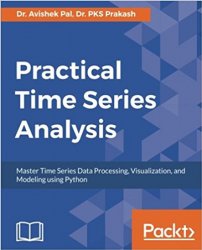
Автор: Dr. Avishek Pal, Dr. PKS Prakash
Название: Practical Time-Series Analysis: Master Time Series Data Processing, Visualization, and Modeling using Python
Издательство: Packt Publishing
Год: 2017
ISBN: 1788290224
Язык: English
Формат: azw3, pdf
Размер: 22,4 mb
Страниц: 284
Time Series Analysis allows us to analyze data which is generated over a period of time and has sequential interdependencies between the observations. This book is about an introduction to time series analysis using Python. We aim to give you a clear overview of the basic concepts of the discipline and describe useful techniques that would be applicable for commonly-found analytics use cases in the industry. With too many projects requiring trend analytics and forecasting based on past data, time series analysis is an important tool in the knowledge arsenal of any modem data scientist. This book will equip you with tools and techniques, which will let you confidently think through a problem and come up with its solution in time series forecasting.
Why Python? Python is rapidly becoming a first choice for data science projects across different industry' sectors. Most state-of-the art machine learning and deep learning libraries have a Python API. As a result, many data scientists prefer Python to implement the entire project pipeline that consists of data wrangling, model building, and model validation. Besides. Python provides easy-to-use APIs to process, model, and visualize time series data. Additionally. Python has been a popular language for the development of backend for web applications and hence has an appeal to a wider base of software professionals.
Chapter 1. Introduction to Time Series, starts with a discussion of the three different types of datasets—cross-section, time series, and panel. The transition from cross-sectional to time series and the added complexity of data analysis is discussed. Special mathematical properties that make time series data special are described. Several examples demonstrate how exploratory data analysis can be used to visualize these properties.
Chapter 2. Understanding Time Series Data. covers three topics, advanced preprocessing and visualization of time series data through resampling, group-by, and calculation of moving averages; stationarity and statistical hypothesis testmg to detect stationarity in a tmie series; and various methods of tmie series decomposition for stationarizing a non-stationary tune series.
Chapter 3. Exponential Smoothing based Methods, covers smoothmg-based models using the Holt-Winters approach for first order to capture levels, second order to smoothen levels and trend, and higher order smoothing is illustrated, which captures level, trend, and seasonality within a time series dataset.
Chapter 4. Auto-Regressive Models, discusses autoregressive models for forecasting. The chapter covers a detailed implementation for moving average (MA). autoregressive (AR). Auto Regressive Moving Average (ARMA). and Auto Regressive Integrated Moving Average (ARIMA) to capture different levels of nuisance within tune series data during forecasting.
Chapter 5. Deep Learning for Time Series Forecasting, discusses recent deep learning algorithms that can be directly adapted to develop forecastmg models for time series data. Recurrent Neural Networks (RNNs) are a natural choice for modelmg sequence in data. In this chapter, different RNNs such as Vanilla RNN. Gated Recurrent Units, and Long Short Term Memory units are described to develop forecasting models on time series data. The mathematical formulations involved in developing these RNNs are conceptually discussed. Case studies are solved using the keras' deep leammg library' of Python.